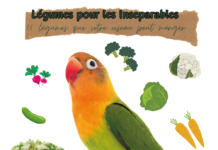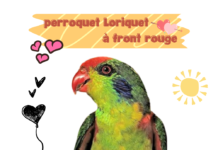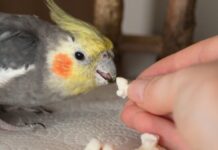Les animaux de soutien émotionnel (ASE) sont des animaux de compagnie (y compris des oiseaux comme les perroquets) qui soulagent des difficultés ou un handicap physiques ou émotionnels.
Ils n’ont pas les mêmes droits légaux que les animaux d’assistance enregistrés, mais peuvent autoriser l’accès à des locaux qui autrement interdiraient ou interdiraient les animaux de compagnie.
Les perroquets sont intelligents, dressables, empathiques et suffisamment petits pour être transportés, ils constituent donc souvent de bons ESA. Un perroquet de compagnie appréciera également le temps supplémentaire qu’il passe avec son propriétaire.
Vous devez créer des liens ensemble si vous voulez qu’un perroquet soit un bon animal de soutien émotionnel. Cela implique de se montrer digne de son affection en établissant une connexion privilégiée.
Les calopsittes, les perruches et les perroquets du Sénégal sont d’excellents animaux de soutien émotionnel. Les aras et les gris africains peuvent être des EMA mais ont des besoins d’entretien et de soins plus élevés.
Pour qu’un oiseau soit un ESA, vous aurez besoin d’une lettre signée d’un thérapeute ou d’un psychologue agréé. Cela doit préciser que la présence de l’oiseau soulage l’anxiété, la dépression, le SSPT, le TDAH ou la douleur physique chronique.
Qu’est-ce qu’un animal de soutien émotionnel ?
Un animal de soutien émotionnel est un animal domestique qui offre compagnie et soutien, atténuant ainsi les symptômes d’un trouble de santé mentale.
Voici des exemples de la façon dont un animal de soutien émotionnel peut améliorer la santé mentale d’un propriétaire :
- Réduire l’anxiété et soulager la dépression grâce aux liens et à la camaraderie.
- Accompagner les propriétaires dans la récupération après des situations traumatisantes.
- Améliorer la santé physique en ralentissant la respiration, en abaissant la tension artérielle et en réduisant la douleur.
- Fournir un sentiment de responsabilité et de détermination.
La plupart de ces fonctions attribuées à un animal de soutien émotionnel peuvent également s’appliquer à un animal de compagnie traditionnel.
À cette fin, Professional Psychology: Research and Practice explique que les psychologues doivent éviter d’attribuer ce statut pour éviter les préoccupations éthiques.
Si un animal de compagnie apporte un confort émotionnel et améliore la vie d’un propriétaire, un professionnel de la santé mentale peut attribuer à l’animal le titre d’animal de soutien émotionnel.
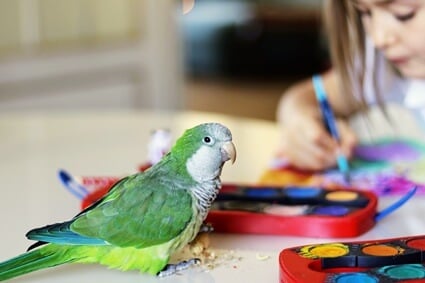
Quels handicaps sont admissibles à un animal de soutien émotionnel ?
Pour enregistrer un animal de compagnie en tant qu’ESA, vous aurez besoin de l’approbation d’un thérapeute agréé. Les conditions qui voient généralement un animal de compagnie transformé en animal de soutien émotionnel sont les suivantes :
- Trouble d’hyperactivité avec déficit de l’attention (TDAH). Un animal de soutien émotionnel peut vous confier une responsabilité qui vous permet de rester concentré sur une tâche importante.
- Learning disabilities or disorders that make it challenging to acquire and retain information, which the presence of an ESA can assist. These difficulties shouldn’t be linked to a physical disability.
- Significant anxiety and depression are reduced through the presence and contact with an ESA.
- PTSD is triggered by sights, sounds, smells, or occurrences, with the company of an ESA reducing the risk of impaired function or panic attacks.
If you have a mental health impairment or condition that an ESA would aid, consider which animal will best meet your needs and seek official documentation that bestows this status.
Are Emotional Support Animals the Same as Service Animals?
As mentioned, ESAs don’t have the same legal rights as service animals. The Americans with Disabilities Act (ADA) only recognizes trained dogs and miniature horses as ESAs.
Emotional support animals are protected by the Fair Housing Act (FHA) 1968.
This means a landlord can’t ban a registered ESA from living with you or charge additional rent or deposit money, even if the property otherwise has a blanket ban on animal inhabitants.
Most local state laws mirror federal regulations, although you must prove you’re taking reasonable steps to prevent the animal from causing a nuisance.
Living with an emotional support animal doesn’t mean you can make excess noise that upsets neighbors or destroys a property owner’s possessions.
Emotional support animals are considered pets outside the home and don’t have the same legal rights as service animals. This means you won’t be entitled to bring an ESA to a private business that doesn’t welcome animals without the owner’s express permission.
Travel is also restricted for ESAs. Attempts to travel by air with emotional support animals often make the headlines, and permission to fly with an animal companion will be entirely at the airline’s discretion.
Can A Parrot Be An Emotional Support Animal?
Many pets can be assigned ESA status. Are birds good emotional support animals? Parrots can be ESAs, but what you get out of the relationship depends on what you put in.
Here are the main reasons why parrots make good emotional support animals:
Intelligence
Many parrots, like budgies, are good at mimicking human words. Teaching them to talk is enjoyable, and certain words can be calming.
Aside from adding to a bird’s vocabulary, parrots can be taught fun tricks like shaking hands, step-up, waving, and playing dead.
These will be a welcome distraction from the stresses of everyday life.
Empathy
As flock animals, parrots are social by nature and value positive interactions.
Parrots are deeply empathetic birds. A parrot will sense your mood and cheer you up with its antics. However, it should never be used as an emotional crutch.
If you approach a parrot in a bad mood, it’ll recognize your negative facial expression. If you’re angry, it’ll shy away from contact through fear. If you’re stressed, it’ll grow concerned for its safety.
Transportation
Bird carriers are available in different shapes and sizes at pet stores. A plastic crate can also work, but not all parrots will enjoy the restraint and lack of visibility.
Many bird owners prefer to travel with a backpack. This will have a perch, so a parrot can position itself in an elevated position, and a clear or mesh window for the parrot to see through.
In many respects, traveling with a parrot in a backpack is akin to allowing it to perch on your shoulder, allowing easy access to your ESA without compromising its safety.
Temperament
Many parrot species are playful and cheerful, seeking opportunities to play. This will distract you from what is causing you stress or emotional turmoil, giving you renewed vitality and focus.
A happy parrot will also elevate the mood in your home, spreading joy and happiness. Play some music, and the parrot may dance. Let your bird out of its cage, and it’ll grow active and play games.
Lifespan
Parrots live longer lives than many common companion animals. This means their owners will benefit from the company of a parrot for a prolonged period, forming a strong and lasting bond.
The lifespan of a parrot depends on the species, with larger birds usually living much longer than smaller birds. This table lists the average lifespan of the most popular pet parrots:
| African grey parrots | 40-60 years |
| Amazon parrots | 40-70 years |
| Budgies | 8-15 years |
| Cockatiels | 10-15 years |
| Cockatoos | 40-60 years |
| Conures | 20-30 years |
| Eclectus parrots | 25-30 years |
| Lovebirds | 15-25 years |
| Macaws | 30-50 years |
| Senegal parrots | 25-30 years |
What Parrot Species Are Good Emotional Support Animals?
Cockatiels are widely considered affectionate and loving species of parrots, making them ideal ESAs. A cockatiel will seek out physical closeness and affection with a bonded owner.
American parakeets (budgies) are also loving and affectionate, seeking to spend time with you. They’re very communicative birds, filling silences with singing, whistling, and trilling.
Senegal parrots love to perch on the shoulder of a favored human, and most choose to spend time with one person over all others. This can lead to co-dependency.
If you have time for their training, African grey parrots can make good ESAs. Some macaw species can also be considered, notably Hahn’s macaws, which are small, vocal, and friendly.
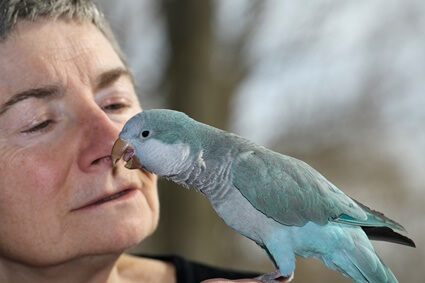
How to Register My Parrot as an Emotional Support Animal
You can apply for EMA status once you’ve adopted a parrot and formed a close bond. This must be given by a licensed mental health professional who’ll provide documentation.
Not all therapists will take on a new patient with the exclusive intent of assigning the emotional support animal status to a pet, so it would be beneficial if you already have a relationship with them.
A health professional will conduct the following assessments:
- The legality of emotional support animals and how your request will fit into local and federal law.
- An assessment of your mental health confirms you’d benefit from an ESA.
- Une enquête sur l’animal et la confirmation qu’il répond à ce que l’on attend d’une AES.
- Observation de vos interactions avec confirmation qu’elle apporte un soutien émotionnel essentiel.
Si un thérapeute est convaincu qu’un perroquet est un ESA, il produira un document de confirmation à en-tête.
Les ressources en ligne peuvent proposer, moyennant des frais, un certificat déclarant un perroquet comme animal de soutien émotionnel. Cependant, ces entreprises ne sont pas légitimes et il n’existe pas de certificat formel de l’ESA.
Selon le Journal of the American Academy of Psychiatry and the Law , seule une lettre signée par un professionnel de santé agréé sera considérée comme authentique par les organismes externes.
[annonce_2]

